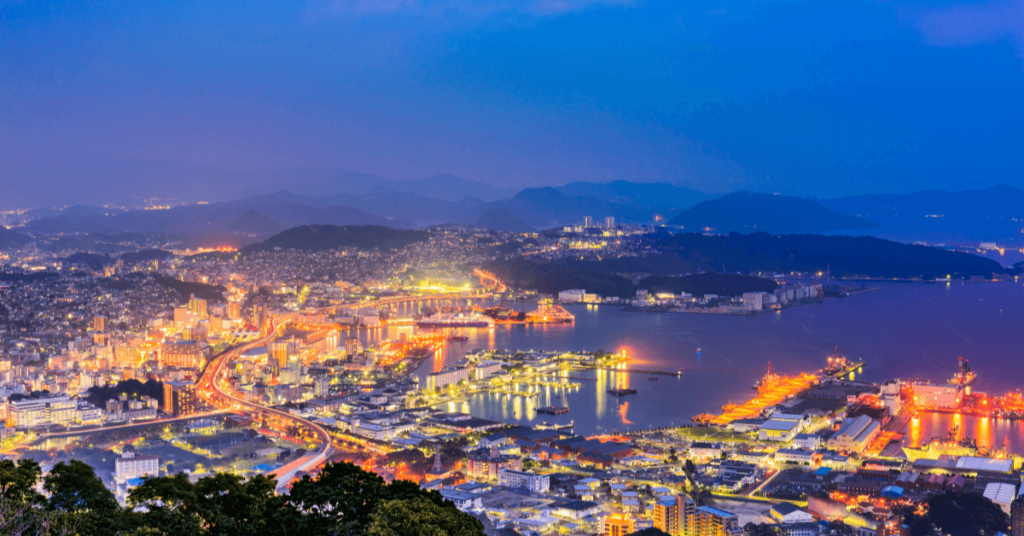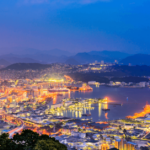9 Major Ports of Cyprus
The island nation of Cyprus lies in the eastern Mediterranean Sea, south of the Anatolian Peninsula and east of the Levant.
Since ancient times, Cyprus has been renowned for its mineral wealth, lush wine production, and scenic beauty. It was a crown colony since 1925 and attained freedom from the British rule in 1960. Its cities have a cosmopolitan yet provincial feel, and its streets are lined with historic buildings.
The island has tall mountains, beaches and fertile valleys. Cyprus lies at the crossroads between Europe and Asia and is a popular tourist destination for Europeans and lovers of nature.
The service sector, led by tourism, contributed 80% to the GDP and employs 70% of the labour force. Second comes the industry and manufacturing sector, which account for one-fifth of the GDP. Agriculture accounts for 2.1% of the GDP and 8.5% of the labour force.
Cyprus exports cement, clothes, pharmaceuticals, citrus fruits, cement and potatoes. It imports food, machines, oil, petroleum products and other consumer goods. Its main trading partner is the European Union, which accounts for 50% of all its trade flows, followed by the Middle East, where 20% of its exports go.
Cyprus has enough ports and harbours to cater to international maritime trade and also cruise ships. Let us explore the major ports of Cyprus in this article.
Port of Limassol
The largest port in Cyprus, Limassol Port, lies on its southern coast and is one of the busiest facilities in the Mediterranean transit trade.
It handles containers, iron, RORO, dry and liquid bulk, timber and ferry passengers. Around 4000 ships, 4,670,000 tonnes of cargo, 418,000 TEU and 381,000 passengers are handled at the port annually.
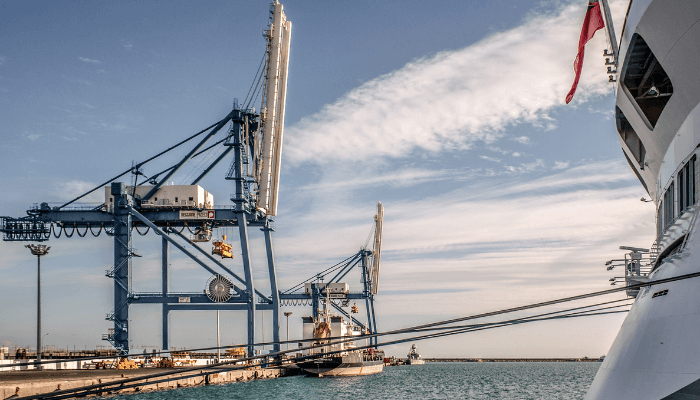
There is a New Limassol Port and an Old Limassol Port. The former is the main port, built after the turkish invasion of 1974, which left the Famagusta Port unreachable since it came under the occupied territory.
Today, Cyprus is a renowned name in the shipping sector, and Limassol City has become a hub for shipping companies worldwide. Most cargo is also handled at this port along with passengers. More than 50 cruise lines include Cyprus in their Mediterranean itineraries.
This port can accommodate ships up to 250 m in a water depth of 14 m through a 15 m deep and 150 m wide approach channel between the ends of 2 breakwaters.
In 2016, it was privatised to a consortium led by Eurogate International for its container handling facility, while DP World became the operator of the passenger terminal.
Limassol Old Port was once the main port of Cyprus. Its foundation was laid in the 19th century, and till 1974, the British RAF 1153 Marine Craft Unit was deployed in the western portion of the port harbour.
Today, it does not handle much cargo but rather functions as a fishing boat and coast guard shelter. There are plans to transform the area and make it a functional leisure hub for tourists.
Limassol Cruise Port
DP World Limassol Port is the main cruise port in Cyprus, lying on its southern coast. It is one of the biggest and busiest ports in the Mediterranean.
DP World Limassol was given a 25-year concession to operate the multipurpose port and the cruise terminal exclusively from Feb 2017. P&O Maritime was also awarded a 15-year concession to provide marine services in the port. The new 7000 sq m passenger terminal began operations in July 2017.
Port of Larnaca
Port of Larnaca is the 2nd busiest port in Cyprus. It is also situated on the island’s southern coast and has 2 breakwaters. It is an industrial hub closest to Nicosia, the capital, and the southeastern agricultural and tourist regions of Cyprus.
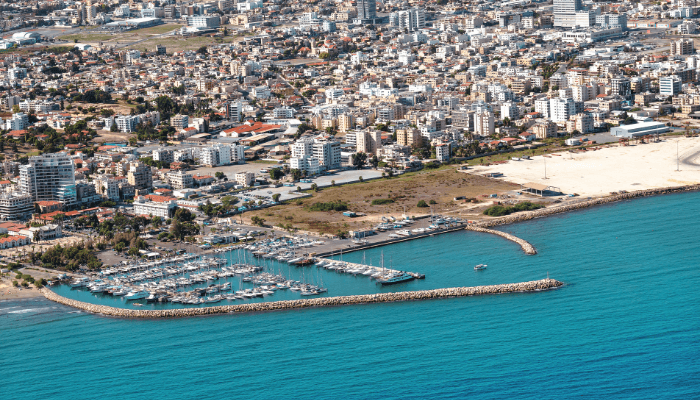
This multipurpose port covers 445,000 m2 and a sea area of 250,000 m2.
The North Quay has an overall length of 326 m and a draft of 10 m, while the South Quay is 340 m long and has a 12 m draft. There are three warehouses for storing cargo.
Larnaca handles containers, motor cars, petroleum products, timber, animal feed, iron, grains, fertilisers etc.
Approximately 2,210,000 tonnes of cargo, 5,090 passengers and 600 vessels are handled annually here.
Dhekelia Oil Terminal
The Dhekelia Oil Terminal is situated on the southern coast of Cyprus, 7 kilometres northeast of Larnaca. It is an open roadstead berth with three mooring buoys. The port has a bottom of mud and sand and provides anchorage and a landing place to Larnanca during northeast winds.
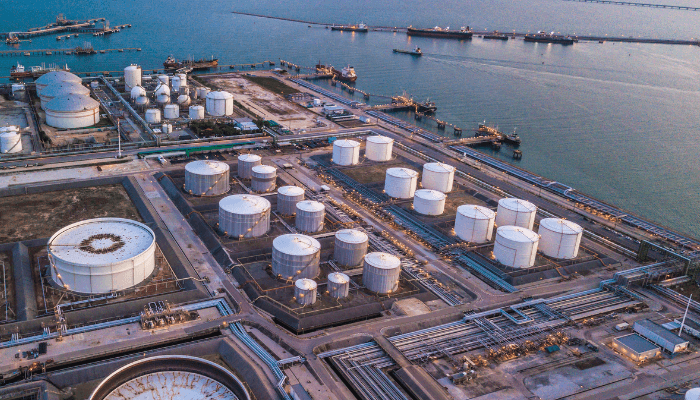
This terminal has installations for unloading fuel from oil tankers to meet the requirements of the electric power station. Around 517,000 tonnes of fuel oil is handled by the Dhekelia Oil Terminal annually.
Famagusta Port
Famagusta is a beautiful city on the east coast of Cyprus, famous for having the deepest harbour on the island.
During the Middle Ages, Famagusta was the most important port city, a gateway to maritime trade with ports of the Levant, from where the merchants of the Silk Road took their goods to western regions of Europe.
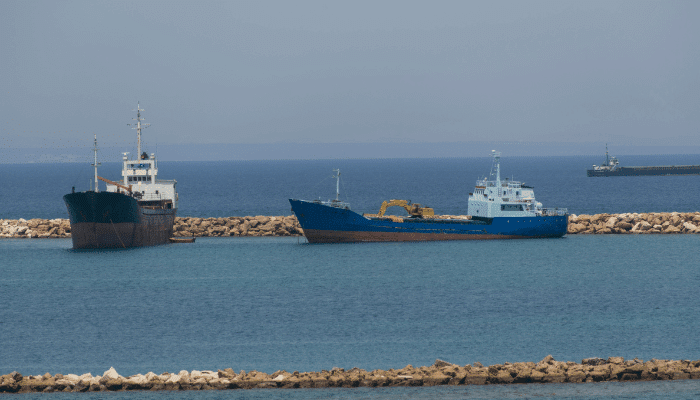
However, the history of Famagusta goes back to the ancient times. It is a natural port that the island’s inhabitants have used since time immemorial. In the 20th century, the British administration undertook construction here for building stone quays, with the first phase of this project commencing in 1898 and lasting till 1905 for 123,000 pounds.
Presently, Famagusta is the principal port in Northern Cyprus. It accommodates all kinds of cargo apart from petroleum products handled at a specialised terminal operated by Cyprus Turkish Petroleum Co.
A part of the outer harbour functions as a free port. It is near the industrial free zone with an extra development area of 554,965 m². Around 500 ships visit this port annually.
Port of Kalecik
Kalecik Port lies on the eastern coast of Cyprus in the Bay of Famagusta, 3 nautical miles west of Cape Elasea. It has a pier which handles bulk and an offshore berth for tankers.
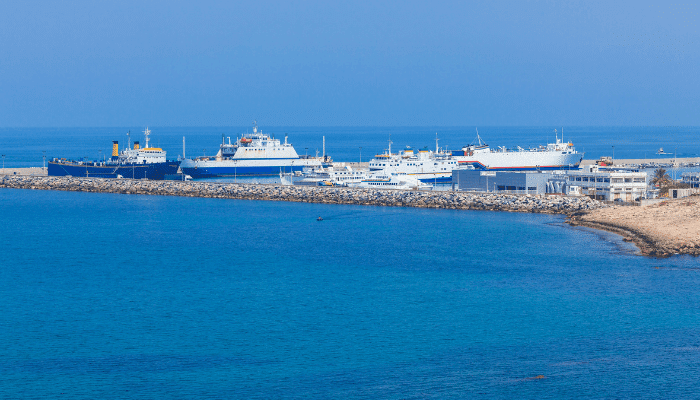
The main imports of this facility are clinker and oil. Approximately 60500 tonnes of cargo is handled at this port every year.
Moni Port
The port of Moni is situated on the southern coast of Cyprus, between Limassol and Vassiliko. It includes an offshore CBM berth in an open roadstead that deals with heavy fuel oil meant for the power station. The berth has a sandy bottom, though there are facilities for fresh provisions, including water supply and electricity and a light machine shop.
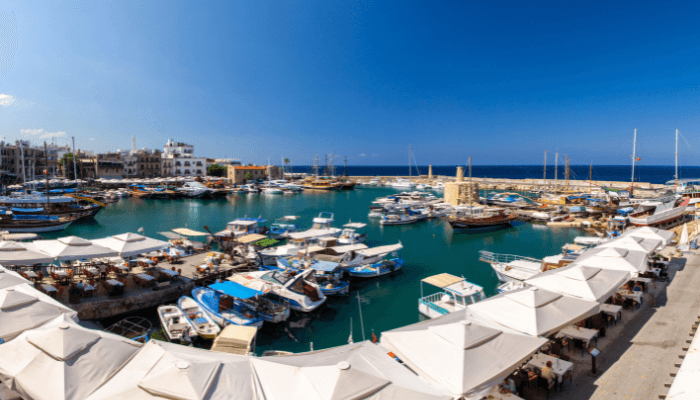
Around 20 ships and 150,000 tonnes of fuel oil are handled at this facility annually.
Port of Kyrenia
Kyrenia lies on the northern coast of Cyprus and comprises an old harbour ideal for small craft and a new tourist harbour for ferries, RORO and cruise ships. Around 70 to 100 ships frequent this port annually.
Kyrenia Harbour has a rich history, and before the British occupation, local fishing boats engaged in a flourishing trade from this harbour.
The people exported olives, wheat, and animals like donkeys and goats, depending on the season and got earthenware, cheese, butter, wood and small luxury items like buttons, cotton, silk, etc. Bigger boats from Europe reached the harbour in autumn and early winter to take crops of carobs, the main export commodity.
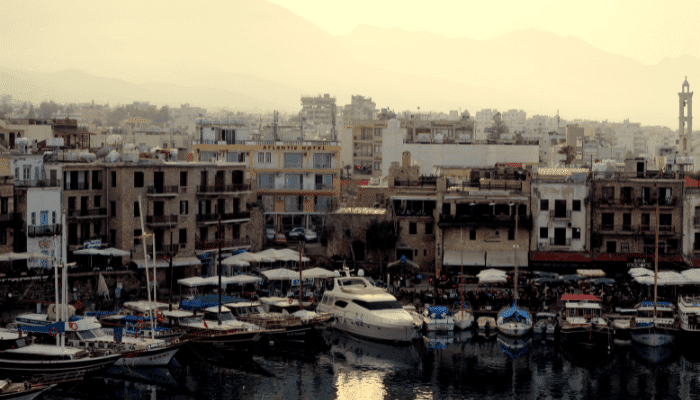
Gradually, 2-storey buildings came up in the harbour. The first floor was used as a warehousing space, while the second was used as a residence by the traders.
The trade with Anatolia and beyond the Levant Sea was heavily affected when, in 1885 the British Government of Cyprus began Kyrenia Harbour Works, leaving the harbour exposed to the strong northern gales.
Many local ships were wrecked within the harbour in the next few years, and their owners suffered heavy losses.
Today, Kyrenia Harbour is a popular tourist attraction on the island, along with its nearby castle, the Jewel of Cyprus. The harbour is surrounded by bars, restaurants and shops that have come up from constructions, which were once Venetian dwellings and warehouses for keeping carobs.
The modernisation of the harbour has kept its architectural integrity intact, and there are no loud noises, neon signs on roads or flashy lights.
Vassiliko Port
Vassiliko port is situated on the southern coast of Cyprus, 15 nautical miles from Limassol. It is an industrial harbour controlled and managed by the Cyprus Port Authority and operated by Vassiliko Cement Works Limited.
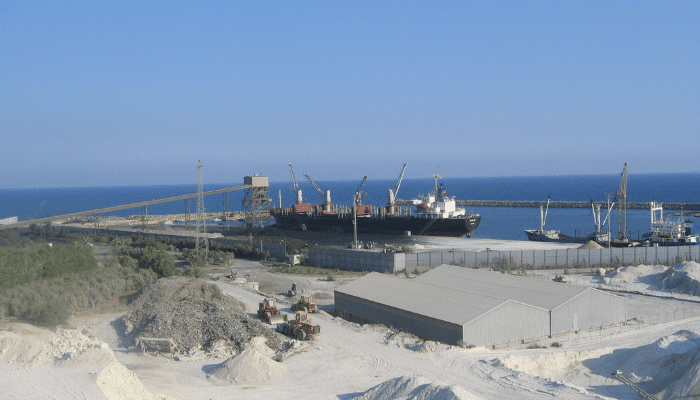
The port is engaged in exporting cement, gypsum and clinker. It handles imports of chemicals, coal and petcoke. Approximately 300 ships and 440,000 tonnes of cargo are handled at the port annually.
The Vassiliko Power Station has an oil berth close to the port, around 1 nm offshore. It is used to discharge fuel oil to the Vassiliko Power Station using submarine pipelines.
Akrotiri Harbour
The Akrotiri harbour, or the Akrotiri Mole, lies southeast of the Akrotiri peninsula within the Sovereign Base Area waters, just 5 nautical miles south of Limassol and 0.3 nautical miles northwest of Cape Gata.
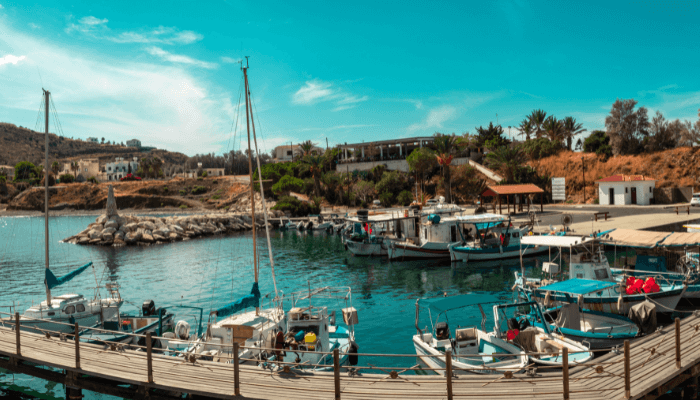
The RAF Akrotiri Mole is a military port with restricted access to commercial vessels without the written permission of the Station Commander.
The harbour includes a basin surrounded by outer and inner arms of rocks with an entry towards the north. There is a tower with a light at both arms to ease navigation, and there are also two dolphins that form a RORO berth.
Smaller Ports of Cyprus
The port of Latchi is located on the northwestern coast of Cyprus. This facility comprises an open roadstead. It was once used for commercial purposes but is now closed to commercial traffic. The only use of this port is to accommodate pleasure boats and local fishing vessels. It welcomes boats with a maximum LOA of 20 m and a draught of 1.5 m.
Morphou Bay is situated on the northern coast of Cyprus and is used for exporting bulk minerals like pyrites. On the west coast lies the Paphos Port, which also accommodates pleasure craft and fishing vessels with a maximum LOA of 30 m and a draught of 2.5 m.
The Port of Teknecik was constructed in 1978 and is a historic facility. It lies 9 nautical miles from Kyrenia on the northern coast of Cyprus. It handles around 140,000 tonnes of fuel oil and 60,000 tonnes of diesel every year.
Conclusion
The strategic geographical location of Cyprus in the eastern Mediterranean is advantageous for its economy and offers many avenues for growth. Its ports are vital centres for promoting regional and global maritime trade. They facilitate the movement of goods and services for the national economy and are a major link in the wider international supply chain.
A few ongoing developments, upgrades and modernisation of port infrastructure will further strengthen the ports of Cyprus and allow them to handle more cargo volumes in the coming years. They are also likely to attract more foreign investors and businesses, especially as Cyprus has a strong maritime industry.
You might also like to read-
- 10 Major Ports On The Great Lakes
- 10 Biggest River Ports In The World
- What Ships Sailed With The Mayflower?
- 10 Largest Natural Ports
- 10 Major Ports In Canada
Disclaimer :
The information contained in this website is for general information purposes only. While we endeavour to keep the information up to date and correct, we make no representations or warranties of any kind, express or implied, about the completeness, accuracy, reliability, suitability or availability with respect to the website or the information, products, services, or related graphics contained on the website for any purpose. Any reliance you place on such information is therefore strictly at your own risk.
In no event will we be liable for any loss or damage including without limitation, indirect or consequential loss or damage, or any loss or damage whatsoever arising from loss of data or profits arising out of, or in connection with, the use of this website.
Do you have info to share with us ? Suggest a correction
Disclaimer :
The information contained in this website is for general information purposes only. While we endeavour to keep the information up to date and correct, we make no representations or warranties of any kind, express or implied, about the completeness, accuracy, reliability, suitability or availability with respect to the website or the information, products, services, or related graphics contained on the website for any purpose. Any reliance you place on such information is therefore strictly at your own risk.
In no event will we be liable for any loss or damage including without limitation, indirect or consequential loss or damage, or any loss or damage whatsoever arising from loss of data or profits arising out of, or in connection with, the use of this website.

About Author
Zahra is an alumna of Miranda House, University of Delhi. She is an avid writer, possessing immaculate research and editing skills. Author of several academic papers, she has also worked as a freelance writer, producing many technical, creative and marketing pieces. A true aesthete at heart, she loves books a little more than anything else.
Latest Maritime Knowledge Articles You Would Like:
Subscribe To Our Newsletters
By subscribing, you agree to our Privacy Policy and may receive occasional deal communications; you can unsubscribe anytime.



